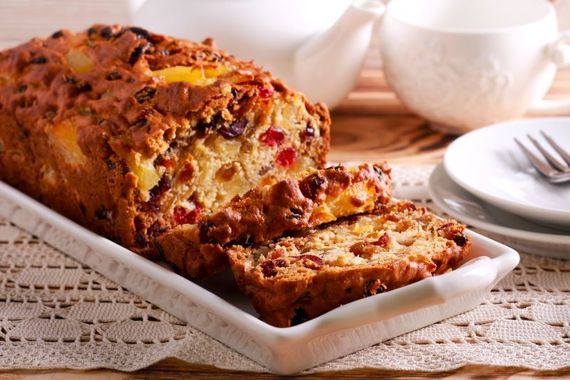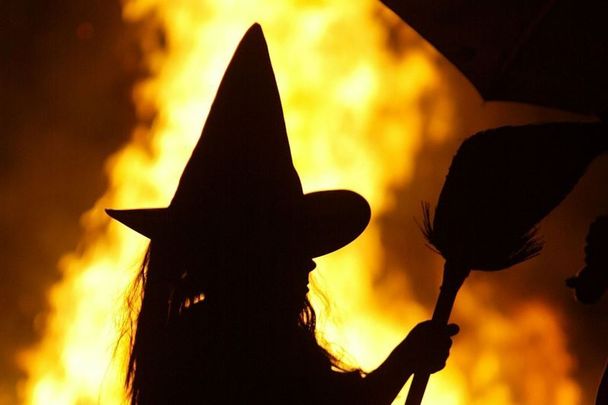A piece of old rag, a dried pea, a coin, and a ring! Remembering barmbracks of our childhood and the Irish folklore and traditions behind the traditional Halloween treat.
Last year, while scrolling through University College Dublin’s National Folklore Collection, Duchas.ie I came across a photograph taken in 1935 of two young girls at Halloween. Although the 1930s were long before my time, nonetheless it brought back some wistful and mostly funny memories of my Halloween growing up in Ireland.
Looking at these two girls seated at the table, one with her buttoned-up tweed coat, happy to have found the elusive gold ring in her slice of Barmbrack and the other looking on, pleased for her sister, I wondered if this was what a normal family must have looked like. In my home, we hovered like birds of prey while our mother sliced the barmbrack hoping to see a hint of the ring and swooping in to choose that slice when we did. It was said that whoever found the ring would be married within the year. Looking back, I'm not quite sure why we were quite so eager to be wed at such a young age!
If you found the bean, then it was a sign of wealth and if you found the pea it meant poverty, the stick meant you would beat your life partner and the rag meant you would be a beggar. Quite horrific by today's standards. Can you imagine telling children that if they found the stick they would beat their life partner? I would probably be reported to some authority for not parenting properly, and yet somehow, despite finding the stick on numerous occasions, I have not been traumatized.
Read more
When trick or treating our costumes were made from black plastic refuse sacks and we gathered our goodies in Quinnsworth plastic bags or pillowcases. We knew where the good houses were. These were the houses that dispensed actual goodies. We craved a fun size Mars Bar, Bounty, or cola cube. We hoped for a few Opal Fruits, fruit salads, or blackjacks but mostly our bags were filled with peanuts, Brazil nuts, apples, and mandarin oranges. After all, they were good for you.
Somehow we have lost the custom of playing Halloween games. Bobbing for apples and apple snapping, distributing soul cakes, and burning the nuts. Our games seemed to be heavily rooted in divination but that is not hard to understand as were a pagan nation long before Christianity arrived. I moved to the United States in 1996 and for the years that followed, I have continued to combine the old with the new, lest I forget my Irish heritage. I make a Barm Brack with browned butter frosting and it is always a welcome treat.
A traditional Irish Halloween barmbrack recipe

Delicious Halloween Barmbrack.
Ingredients
- 2 cups flour
- 1 cup raisins
- 1 cup golden raisins
- 1 egg
- 1 cup cold tea
- 3/4 cup extra fine granulated sugar
- 3/4 cup milk
- 2 tablespoons whiskey
- 1 teaspoon allspice
- 1 teaspoon baking powder
- 1/4 teaspoon nutmeg
Trinkets
- a small piece of rag
- 1 dried pea
- 1 cent or nickel
- ring
Method
Soak the fruits overnight in cold tea & whiskey.
Preheat oven to 350F degrees.
Grease a 1lb loaf pan.
Wrap each trinket in a small piece of parchment paper.
Add the sugar, baking powder, and spices to the flour. Lightly whisk the egg and add the milk. Combine all ingredients until thoroughly mixed.
Place wrapped trinkets into the mixture.
Pour into lined pan and bake for 60 - 70 minutes. You can test by inserting a skewer, it is ready when the skewer comes out dry. Remove from the tin and let cool on a wire cooling rack.
Frosting
4 tablespoons unsalted butter
1 cup sifted powdered sugar
1 teaspoon vanilla
1-2 tablespoons milk
In a small saucepan melt the butter and warm until a golden brown color. About 7 minutes. Sift the powdered sugar into a bowl. Add the vanilla and 1 tablespoon of milk. Gradually stir in melted butter, leaving behind remaining sediment in the saucepan. Mix until smooth and if needed add an additional tablespoon of milk. Cool for a few minutes then spread on the Barm Brack.
Slice and spread with Kerrygold salted butter. Simply nothing better!
*Originally published in October 2021. Updated in October 2024.
This article was submitted to the IrishCentral contributors network by a member of the global Irish community. To become an IrishCentral contributor click here.




Comments